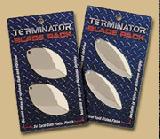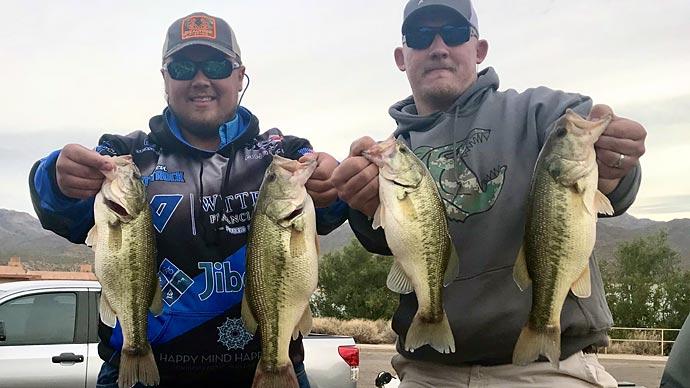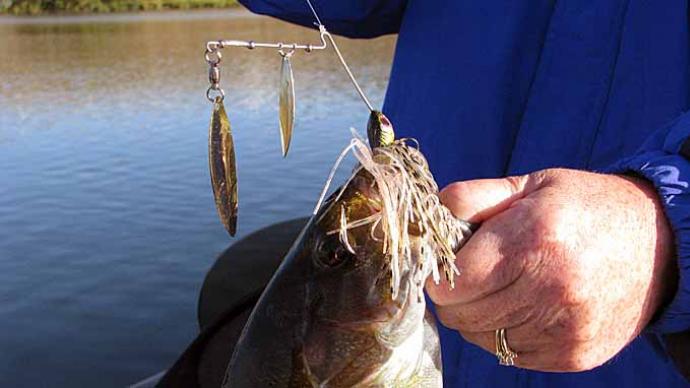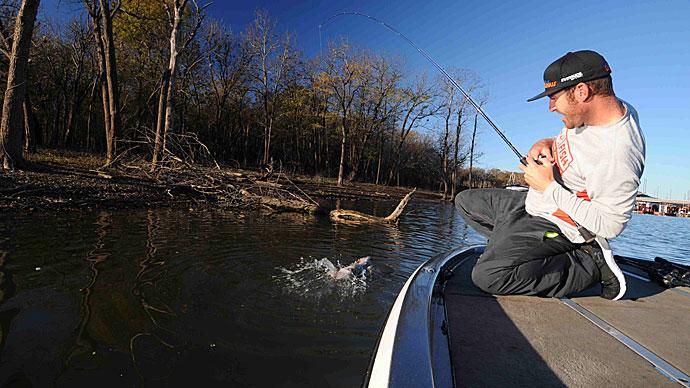
Accomplished tournament anglers wouldn't dream of discarding a proven lure for the latest fad. They also don't want to give their competitors an edge by ignoring genuine innovations. The compromise—instead of replacing tried and true bait with something new, which many ineffective anglers do, they add fresh lures to their ever-growing arsenals.
The Colorado blade is just as deadly now as ever, but many bass anglers overlook it these days. It's used primarily as a small complement to a larger willow leaf blade. Though many anglers carry spinnerbaits in their tackle boxes that feature Colorado blades, these lures serve as window dressing for willow leaf spinnerbaits that get most of the action. Arkansan Rob Kilby hasn't fallen into this trap.
"When I started bass fishing, I didn't know what a willow leaf blade was," says Kilby, who has qualified for four Wal-Mart FLW Tour championships. "All spinnerbaits came with round blades back then. The willow leaf craze hit in the late 1980s. Since then, everybody's been throwing mostly willow leafs. Most fishermen don't pay much attention to Colorado or Indiana blades anymore."
Kilby claims his spinnerbait box houses more Colorado blades than willow leafs and that the round blades have come through for him many times in high-dollar tournaments. He sticks with round blades because relatively few anglers fish them. In other words, the "old" Colorado blade shows a new look to bass that have grown accustomed to a never-ending parade of willow leaf blades.
The difference between a round Colorado blade and a long, narrow willow leaf blade is dramatic to a bass. The willow leaf spins in a tight arc and causes little water resistance. It excels when it comes to emitting flash but doesn't generate much in the way of vibrations. The Colorado blade spins in a wide arc, creates more lift, and is the king of good vibrations.
"Round blades are much better in dingy or dirty water because their strong vibrations help bass track down the lure," Kilby says. "The dirtier the water, the bigger the blade you want to use."
Kilby prefers a single Colorado blade when he slow rolls a spinnerbait during the fall and winter months. The single blade thumps the rod tip with each revolution, which allows him to feel exactly what the lure is doing throughout the retrieve. When the thumping suddenly stops, chances are a bass has engulfed the bait.
"If I'm slow rolling down to 5 or 6 feet," Kilby says, "I go with a 3/8-ounce spinnerbait and a No. 4 Colorado blade. To get 10- to 12-feet deep, I switch to a 1/2-ounce spinnerbait and a No. 5 blade."
Kilby concentrates on secondary points close to a creek channel when slow rolling a spinnerbait during the cold months. In most instances, there is no visible cover, but the point may have scattered stumps or boulders beneath the surface that attract bass. On some waters, submerged vegetation offers another option: Kilby's pattern last spring during a Wal-Mart FLW Tour event on the Pascagoula River in Mississippi. Slow rolling a 1/4-ounce Colorado-bladed spinnerbait through spotty patches of eelgrass produced enough bass for Kilby to claim third place in the contest.
"I was just bumping the grass with the spinnerbait," he says. "You couldn't see the grass in the dingy water. You had to find it with the spinnerbait."
A tandem Colorado spinnerbait gets the call when Kilby wants to increase the tempo and run a lure near the surface. The lift provided by two blades makes it easy to run a spinnerbait high. If the blades are close in size, say, a No. 3 and a No. 4, they tend to offset each other and subdue the vibrations you feel through the rod tip. Nevertheless, a pair of round blades still sends strong vibrations through the water that call out to bass.
Running a tandem spinnerbait high works incredibly well for Kilby in the fall when bass feed along steep channel banks on the main lake. He eases his boat ahead close to the bank and retrieves the spinnerbait parallel to the rocks no deeper than 18 inches.
"Your boat could be sitting over 40 to 50 feet of water, but you still get bites up near the surface," Kilby says.
In the summer months, Kilby heads up major creeks that feed large impoundments where he finds shallow bass in stained to muddy water. Due to the low visibility, round blades reign. In this situation, he prefers a 3/8-ounce spinnerbait with a No. 2 1/2 and a No. 4 Colorado blade. If the bass are active, Kilby retrieves the spinnerbait high next to stumps, windfalls, and whatever other visible cover is available. When the bass are less aggressive, he runs the bait out of sight.
"When the spinnerbait goes by a piece of cover, hesitate the retrieve for just a second, and the bass will come out and smack it," he says.
Whatever size spinnerbait Kilby selects, he ties it to 17- or 20-pound monofilament and fishes it with a 7-foot, medium-action fiberglass baitcasting rod and a 5:1 gear ratio reel. Kentucky angler David Walker also relies on 17- and 20-pound line when he fishes Colorado-bladed spinnerbaits, which he does regularly. Where Walker differs from Kilby is with the size of the spinnerbait and the blades he employs. Walker believes bigger is better.
"I fish heavier spinnerbaits than most people," he says. "Very seldom do I go as light as 3/8 ounce. Most of my spinnerbaits weigh 1/2-, 5/8- and 3/4-ounce. I catch a lot of bass with a single No. 6 or 7 Colorado blade. With a big blade like that, you must use a heavy spinnerbait to keep the lure from rolling over."
The large single spin scores exceptionally well for Walker in the spring during the spawning phase. When other anglers twitch jerkbaits over the bass, Walker slowly rolls the oversized blade near the bottom of the bass' face. These fish are typically 6- to 10-feet deep and not visible. Walker runs the bait over bottoms where bass spawn.
"This approach works great on smallmouth bass," he says. "They like to spawn on steep shale banks with little ledges. I just run the spinnerbait down parallel to the ledges. Smallmouths nail the bait when it comes by them."
Big blades get the nod even when Walker fishes a tandem Colorado spinnerbait such as a No. 4 or 4 1/2 blade ahead of a No. 6. He favors two blades in muddy water and also when he needs a heavy kicker fish for the livewell.
Two of Walker's most productive retrieves with the big tandem spinnerbait include walking the lure and pitching it next to laying logs and other cover, as you would a jig. With the latter presentation, he pulls the spinnerbait along briefly next to the cover and then pitches to another target. The big, round blades let him keep the spinnerbait working in the strike zone a few moments longer.
Though Colorado spinnerbaits work wonders for Walker in the abovementioned situations, he recommends giving round blades a workout anytime bass are hitting spinnerbaits. Even if the bass are taking a spinnerbait sporting willow leaf blades, they may respond better to Colorado blades, or vice versa.
"You have to experiment with different blades to see what the bass prefer," Walker says. "Little things like this separate a good limit from a winning catch."
A friend of Walker's reinforced this point a few years ago during an FLW Tour event on Beaver Lake in Arkansas. The tournament was underway, and Walker caught bass by retrieving a spinnerbait rigged with willow leaf blades over rocky banks. The problem was that the bite was slow. Walker mentioned this to his friend when they met by happenstance while fishing the same bank.
"You have to be kidding me," said his friend. "We're killing them on spinnerbaits. Check this out."
With that, Walker's friend revealed his spinnerbait. It looked similar to Walker's lure. The difference was that his friend's bait had round blades.
"I stopped right there and dug some similar baits out of my tackle box," Walker says. "The difference was dramatic. Thanks to those old round blades, my partner and I were culling bass within an hour."
Content provided by Bass Fishing Magazine, the official publication of FLW Outdoors




